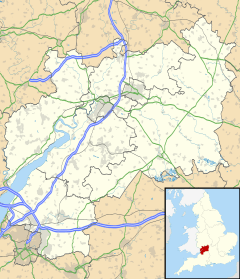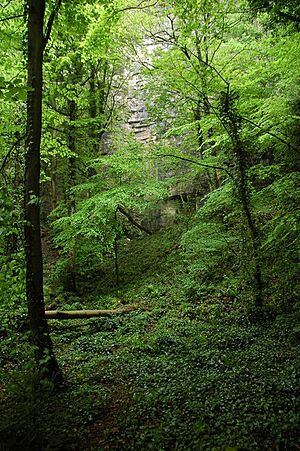Lower Wye Gorge SSSI facts for kids
| Site of Special Scientific Interest | |

River Wye at Lancaut, looking towards Wintour's Leap
|
|
| Area of Search | Gloucestershire |
|---|---|
| Grid reference | ST548983, ST537967 |
| Coordinates | 51°39′58″N 2°39′58″W / 51.666°N 2.666°W |
| Interest | Biological/Geological |
| Area | 65 hectare (Natural England from unit assessment information) |
| Notification | 1954 |
The Lower Wye Gorge is a special place in Gloucestershire, England. It's known as a Site of Special Scientific Interest (SSSI) because of its amazing plants, animals, and geology. This area covers about 65 hectares, which is like 160 football fields!
The Lower Wye Gorge was first recognized as important in 1954. It includes two nature reserves managed by the Gloucestershire Wildlife Trust: Ban-y-gor Wood and Lancaut. These woodlands are also part of a larger protected area called the Wye Valley Woodlands, which is a Special Area of Conservation (SAC) under European rules.
Discover the Lower Wye Gorge
The Lower Wye Gorge is located in the beautiful Wye Valley Area of Outstanding Natural Beauty. The woodlands here are super important for nature in the United Kingdom. They are natural forests that stretch along the sides of the gorge.
These woods have many different types of trees. They are thought to be very similar to the original forests that grew here long ago. You can find some rare and special plant and animal species living here.
The Lower Wye Gorge is divided into two main parts:
- One part is about 26 hectares and includes the Ban-y-gor Wood nature reserve.
- The other part is about 39 hectares and includes the Lancaut nature reserve. Wintour's Leap is also part of the Lancaut reserve.
Explore Lancaut Nature Reserve
Lancaut nature reserve is about 24 hectares in size. It sits on the east side of the Wye Gorge, just north of Chepstow. The gorge here is made of huge limestone and sandstone rocks. It rises about 250 feet above the River Wye, which has tides that go in and out.
The reserve includes Lancaut Wood, Pen Moel, Chapelhouse Woods, old quarries, and limestone cliffs. It also has a special area called a saltmarsh. This is one of the few places in the United Kingdom where you can see how a saltmarsh naturally changes into a valley woodland. Lancaut became a nature reserve in 1971.
You can walk through the woods on a public footpath. It goes from the old ruins of Lancaut Chapel to below Pen Moel. You can return by following the Offa's Dyke Path.
Trees of Lancaut
The steep hillsides and old limestone quarries have created a very diverse forest. Many different types of trees grow here.
Some of the trees you might see include:
- Pedunculate oak
- Ash
- Field maple
- Yew
- Small-leaved lime
- Wild service-tree
- Wayfaring tree
- Rare whitebeams
Ground Flora of Lancaut
The plants growing on the ground include many ferns. In spring, you'll see a beautiful display of flowers like:
- Primrose
- Bluebell
- Dog-violet
- Wood anemone
- Early purple orchid
Other interesting plants found here are green hellebore, bird's nest orchid, and fingered sedge. On the open rock faces, cliffs, and in the old quarries, you can find wildflowers such as:
- Hairy violet
- Yellow-wort
- Lesser calamint
- Oxeye daisy
- Red valerian
- Shining crane's-bill
The saltmarsh area has its own unique plants, including sea aster, English scurvy-grass, sea milkwort, and buck's-horn plantain. There are also many different kinds of lichens and mosses.
Birds and Mammals of Lancaut
Lancaut's south-facing cliffs are popular nesting spots for peregrine falcons and ravens.
A wide variety of birds have been seen here, such as:
- Sparrowhawk
- Goshawk
- Kestrel
- Cormorant
- Heron
- Shelduck
- Wood warbler
- Lapwing
- Goldcrest
Conservation Efforts at Lancaut
To help the grassland plants grow, people work to control invasive Sycamore trees. They also remove scrub from the rocky areas. A big challenge here is the erosion of the saltmarsh, which can happen naturally or because of human activity.
Discover Ban-y-gor Wood
Ban-y-gor Wood is about 23.2 hectares in size. It faces north, so it's a darker, cooler, and wetter forest than Lancaut. The Clay Estate donated this wood to the Gloucestershire Wildlife Trust in 1995.
The wood slopes down about 100 meters to the edge of the River Wye. The slopes are very steep, with areas of cliffs and bare rocks. Even though it's steep, there's evidence that people used to quarry here. You can still see old winding gear that was used to pump water from the river.
This is a quiet, hidden habitat, covered with ferns and mosses. It has large, old coppice and pollard trees. A single path goes down through a small clearing towards the river.
Trees of Ban-y-gor Wood
The main trees in Ban-y-gor Wood include:
- Beech (some very old ones)
- Ash
- Sessile oak
- Silver birch
- Common whitebeam
- Small-leaved lime
Yew trees are very common here, especially under the beech trees. Other shrubs and small trees include hazel, field maple, hawthorn, holly, and goat willow. There's even a rare hybrid tree here, which is a mix between a rowan and a whitebeam.
Ground Flora of Ban-y-gor Wood
Because the conditions are damp and a bit acidic, you'll find different plants on the ground. These include:
- Foxglove
- Woodruff
- Tutsan
- Slender St John's-wort
- Wild madder
- Great woodrush
- Wood sage
- Bilberry
- Wood sorrel
Many ferns grow here, such as hard shield fern, hard fern, scaly male-fern, and maidenhair spleenwort. The general woodland flowers include bluebell, wood anemone, primrose, dog-violet, and yellow archangel. You'll also find many types of mosses and liverworts.
Mammals of Ban-y-gor Wood
Dormice have been seen living in these woodlands.
Conservation Efforts at Ban-y-gor Wood
To make the forest more varied, small clearings and coppice areas are cut. This is especially done along the path, which helps different plants and animals thrive.




